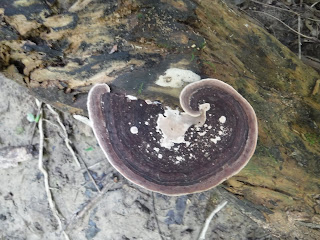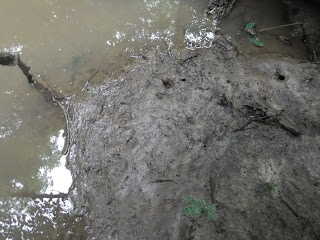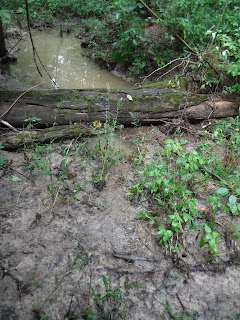The Known and the Anomaly
September 6, 2019
I went down to Cottonwood Pond in the
early afternoon of that breezy, sunny day, glad that it was not a hot
one. A Pewee sang its name and the buzz of cicadas emanated from the
trees. Spider webs were strewn across open spaces, some sparkling in
the sun.
I heard a quick rustle of leaves as a
nut fell through the canopy, and a small thud as it hit the woodland
floor. Did it loosen and fall from a branch, or was it dropped by a
squirrel? Either way, it was a sign that the year was beginning to
turn from summer toward autumn.
Bitternuts fallen onto the
bed of Cottonwood Pond
Sunlight was strong and fierce,
breaking through openings in the canopy, illuminating the woodland
only in intense, bright spots so dappled and distinct that the
surroundings were distorted.
The dry woodland slope
Wooded slope to the southeast
Wooded slope to the northwest
Cottonwood Pond within the light
Though the slope seemed bone-dry, the
Creek was dribbling along. I could see dampness and recently formed
flow patterns throughout the Cottonwood Pond area.
The Creek before and after
the Barkless Log
The “Island” forming to
the downstream side of the Barkless Log
Debris dammed between the
Barkless Log and a smaller log, between the Inlet and the Creek
Where the Seep meets the
Creek – exposed muddy area riddled with animal tracks
Exposed mud in the flow path
under the Cottonwood Trunk – with tracks showing that deer had
passed below the Trunk (something I do with great effort), not
jumping over it
Near Cottonwood Pond, moving
water has gradually exposed the sinuous roots of two young saplings
The bed of Cottonwood Pond had no
standing water, not even a little puddle, but the bottom was muddy,
showing signs of a microcosm of activity.
Though it was very still at Cottonwood
Pond, I saw the motion of something running toward a crawdad hole
(the chimney had been swept away) and disappearing into it. I don't
think it was the crawdad, but otherwise I could not see any details.
Washed-off Crawdad hole with
Raccoon track
Raccoon tracks
Worm trails
A curious anomaly had appeared in the
bed of Cottonwood Pond.
It looked as if something had been
digging. But, why was it digging there? And, why were the edges of
the hole squared off??
Crawdads had built soft, new little
chimneys at the edge, likely the previous night, so this anomaly had
to happen the day before.
These pieces of roots had fallen from
the Root Ball some time ago. Over time, they have been sculpted by
rushing water and were gradually being buried in the mud.
The Root Ball, which had started as a
full semi-circle, had lost soil over the years due to the actions of
weather (mostly rain) and gravity, dropping its soil to the soggy
ground below and exposing more of its roots. The Cottonwood had
become a world of transition between old and new life, its old roots
crumbling, but yielding to and supporting new tree saplings.
The Root Ball, seen from the
north, showing the Mud pile and the bed of Cottonwood Pond
The Root Ball Top, seen from
the north, showing the Root Ball Top, the Cottonwood Trunk, and the bed of "little pond"
Large roots exposed where the
Root Ball Bottom meets the Mud Pile below
A long root exposed on the
Root Ball Top
Earlier this year, one of the saplings
at the north edge of the Root Ball lost its footing as more soil
eroded from around its roots, then the whole sapling tipped over
across the nearby Isthmus.
I wonder at the fate of the other
saplings growing from the Root Ball. They grow from side edges, the
top edge, and even from the base of the Trunk, and along the top of
the Trunk. Some are larger than the fallen sapling.
Will they all tip over before maturity,
sliding to the floor below, or will some experience the fortune of
maintaining a strong foundation of soil beneath them, and continue to
grow fairly straight?
Meanwhile, critters had been chewing
away at old wood in the area, looking for food, or making burrows for
shelter or egg-laying, and creating sediment for new soil.
And, critters have been chewing at
leaves all summer, feeding themselves and hastening the demise of
the leaves, which would someday fall and also become soil.
Wood Nettles
Boxelder
The stiff leaves of Hackberry trees
were also quite chewed up, but I noticed groups of new, supple,
bright green leaves at the ends of branches.
All of this activity, all of this
cycling of Life, continued to support new growth, even at this
seasonal tipping point.
Blue Mistflower
Orange Jewelweed in bloom on top of the Mud Pile
Orange Jewelweed in the bottoms area near Cottonwood Pond
Tribbles on the Cottonwood Trunk?
Nope - a slime mold called Comatricha typhoides
Virginia Smartweed
The same pretty shelf mushroom I showed in the previous blog post, but now showing deterioration
I may never know the answer to how the
strange anomaly on the bed of Cottonwood Pond was created. But, I
will always observe, seek answers to my questions, and learn more
along the way. And, the more one learns, the more questions one has.





































































































